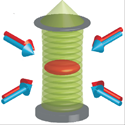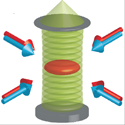Less wiggle room for the gravitational constant
Ultracold atoms have proven their value as test beds for creating new quantum states of matter and simulating how electrons behave in solids. Trapped and cooled atoms have also taken a starring role in high-precision measurements of fundamental constants and in atomic clocks. Writing in Physical Review Letters, Nicola Poli and colleagues at the University of Florence, Italy, report their use of ultracold strontium atoms to push forward our knowledge of Earth’s gravitational constant.
Building on prior proposals to use atoms captured in optical traps, Poli et al. transfer roughly one million strontium-88 atoms at into a vertically oriented optical lattice. Since the atoms move in a periodic potential, they undergo Bloch oscillations, similar to electrons in a solid-state lattice under the influence of an applied electric field. Bloch oscillations arise when the induced momentum change of the particle caused by a field interacts with the band structure of the lattice. In Poli et al.’s experiments, however, the applied field is gravity. By imaging the cloud of strontium atoms undergoing Bloch oscillations, the authors were able to measure the acceleration due to Earth’s gravitational field, , to within and compare the result with measurements by the best conventional gravimeter.
The authors say that their hope is that by optimizing the technique, measurements might become possible that test general relativity, theories of quantum gravity, and deviations from Newtonian gravity. – David Voss





